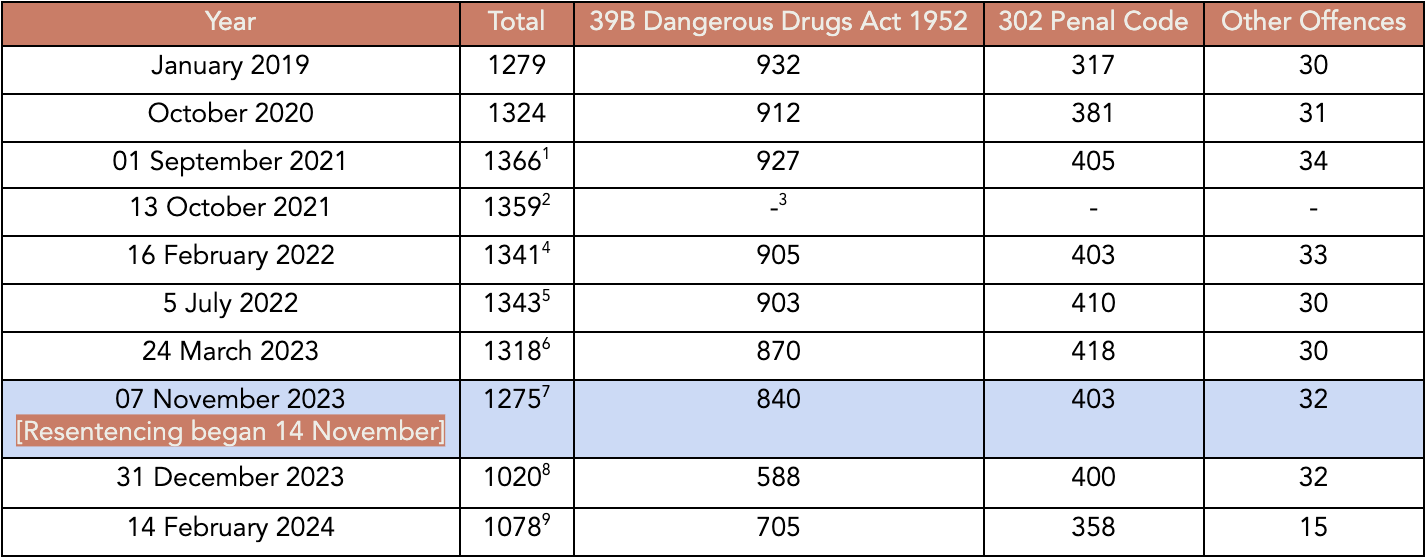Observed Trends Post-Abolition of the Mandatory Death Penalty in Malaysia
Malaysia underwent significant policy changes on the death penalty in 2023. Malaysia abolished the mandatory death penalty in its criminal justice system but maintained the death penalty as a possible sentence for offences that it considers the ‘Most Serious Crime’. This includes offences that involve the intentional killing of another person and drug trafficking.
This amendment gave hope that the death penalty would be scaled back and eventually phased out in line with commitments by various administrations towards the abolition of the death penalty.
The data collected indicates that the early hope that the abolition of the mandatory death penalty will herald the eventual abolition of the death penalty does not seem to be reflected in the present developments.
Diagram 1: Overview of the Death Penalty and OffencesDiagram 2: Changes in Death Row PopulationAt the start of the resentencing process, it was reported by the government that 936 individuals were eligible for a review of the death sentence. As of May 2024, 474 individuals have undergone resentencing with 19 of them having their death sentence retained. 462 individuals are still waiting for their hearing to take place.
Despite having 455 individuals resentenced to life imprisonment, the number of persons on death row remains significant with signs of it increasing after the initial reduction following the abolition of mandatory death penalty and the start of the resentencing efforts. However, it must be noted the increase has not been confirmed with further data up to 31 May 2024.
The number of persons on death row who have not exhausted the legal process in November 2023 was 339 individuals. With the start of the resentencing process, we decided to classify this group of death row inmates as the new ‘total’ number of persons on death row.
The rationale behind this is due to the decreasing number of persons who have exhausted all legal avenues since November 2024, following the start of the resentencing effort. We have seen the number of individuals in this category gradually decrease from 936 individuals to only 462 as of May 2024. As time passes, we would expect this number to decrease further with those with the death sentence maintained eventually to be added back into the new total on the death row population.
A review of the data indicates several concerning developments:
Significant increase in new convictions or overturned acquittals by the High Court, Court of Appeal or Federal Court
As noted before, those who have exhausted all legal avenues before the resentencing process have gradually declined in number with 462 individuals awaiting their resentencing hearing as of 31 May 2024. However, this decline has not been reflected in a proportionate reduction in the overall number of death row populations.
The overall population has decreased from 1275 (November 2023) to 1020 (31 December 2023) and increased to 1058 (February 2024). While we are still awaiting further data on the death row population as of 31 May 2024, preliminary data indicates new convictions are likely contributors to the plateauing number of persons on death row.
This is more concerning when we look at the March 2024 Parliament question that provided a general breakdown of offences committed by those on death row.
Diagram 3: Changes in Population Distribution based on OffencesSignificant inconsistencies or volatility in new drug trafficking cases under Section 39B of the Dangerous Drugs Act 1952
In early sections, we suggested that the plateauing death row numbers between 31 December 2023 to 14 February 2024 was largely attributable to the significant increase in the number of persons landing on death row for drug offences.
It must be noted that the 1020 and 1078 persons respectively still include those who are still awaiting resentencing at the respective period. We know from other data sources that all persons convicted of drug trafficking under Section 39B of the Dangerous Drugs Act 1952 had their death sentence commuted during the resentencing process.
The concern for volatility arises from the following factors:The number of persons resentenced between 7 November 2023 to 31 December 2023
The proportion of death row inmates between drug trafficking and murder has consistently held at a 2 to 1 ratio for the past decade.
The known numbers of resentencing that took place between 14 November to 31 December 2024
Diagram 4: Changes in Population Distribution based on Offences with Breakdown Estimation for the Number of Persons Eligible for ResentencingReferring to the table above that contains the estimation based on historical data and documented cases, it would suggest that a small fraction (26) of the persons eligible for resentencing (602) for drug offences had been resentenced. Of the 252 people who have been removed from death row, only a small minority 26 people were through the resentencing process. The others are likely persons who were successful in their appeal against their conviction at the High Court or the Court of Appeal.
At this point, this is a conjecture based on the estimates and data collected, but it is unlikely for there to be any significant divergence as any divergence would indicate the proportion of offences for persons eligible for resentencing is significantly different from the overall death row proportions. Our internal monitoring data has thus far indicated a similar proportion of cases resentenced.


